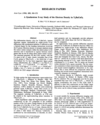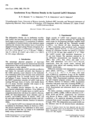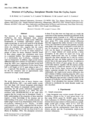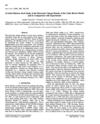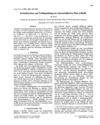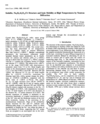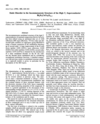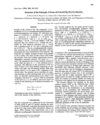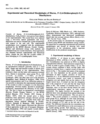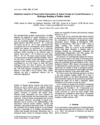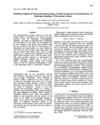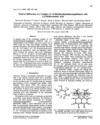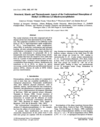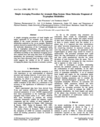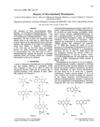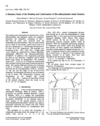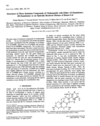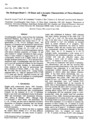issue contents
August 1996 issue

Cover illustration: Molecular structure and packing of 7-dispiro[2.0.2.1]heptane carboxylic acid. Courtesy of D. S. Yufit, P. R. Mallinson, K. W. Muir, S. I. Kozhushkov and A. De Meijere.
research papers
Download citation


Download citation


The features in a synchrotron radiation Δρ image for Y2BaCuO5 are predominantly due to exchange depletion of the electron density between second nearest-neighbour cations.
Download citation


Download citation


The deformation electron density in LaOCl measured with synchrotron X-radiation accumulates in the inter-layer region stabilizing the structure that contains layers of positively charged Cl atoms.
Download citation


Download citation


The structure of the heavy fermion compound Ce2Pt6Ga15 has been determined from neutron powder and X-ray/neutron single-crystal diffraction. The structure is unusual in that Ce layers have 1/3 of the Ce atoms replaced by groups of three Ga atoms. Weak diffuse scattering suggests that disorder arises from a lack of registration of successive Ce2Ga3 layers.
The electronic charge density of cubic BN and structure factors are calculated at the ab initio Hartree-Fock level. It reveals the semi-covalent character of the BN bond and a charge transfer from B to N close to unity. Comparison with experiments leads to a satisfactory agreement.
The valence charge and difference densities of GaAs were calculated without foregoing refinements of a charge density model using six different data sets published until now. Only four of these describe the covalent bond as well as the partial charge transfer between neighboring atoms in qualitative agreement with the theoretical prediction.
Download citation


Download citation


A new triclinic structure type adopted by the high-temperature polymorph of an intermetallic phase was prepared.
Download citation


Download citation


The structure of Sb2WO6, previously reported in the space group P1, is re-refined in P-1 as a 2a x 2b x 2c superstructure, improving the residual R from 0.12 to 0.04. Synthesis of the isostructural phase Sb2MoO6 is also reported.
Download citation


Download citation


Refinement of the high-temperature structures of sodalite (295-1200 K) based on single-crystal neutron diffraction and an anharmonic thermal vibration model for Na+, Cl− and O indicate (i) the thermal expansion from an untwisting of the aluminosilicate framework due to increasing translational motions of Na+ coupled with librations of SiO4/AlO4 tetrahedra and (ii) Na+-Cl− diffusion along <111> channels.
The incommensurate modulated structure of the high Tc superconductor Bi2Sr2CaCu2O8+δ has been explained on the basis of a disorder of the Bi atom.
Download citation


Download citation


The structure of the polytypic form of the title compound can be described in terms of a layer structure which contains an ⋯ABAABA⋯ repeat pattern of layers. The A and B layers have pseudoslab symmetries pc2a and p21/c11, respectively.
CCDC reference: 131879
Download citation


Download citation


s part of the molecular recognition studies on auxins, a series of indole-3-acetic acids fluorinated at the phenyl ring positions 4, 5, 6 and 7 has been examined. Structural studies based on X-ray structure analysis, computational chemistry methods and some physico-chemical properties are presented and correlated with bioassays performed on the Avena and Pisum sativum.
Download citation


Download citation


The experimental morphology of diuron crystals, a weed killer, is compared with the theoretical morphology determined using both a geometrical observation law and molecular mechanics calculations.
CCDC reference: 131883
Download citation


Download citation


The effect of substitution on the bonding in the polyspirocyclopropane frame and chemical behaviour of the title compound is discussed in terms of the topological analysis of experimental multipole charge density distributions.
CCDC reference: 131884
The high capacity of the sulfate dianion to form multiple hydrogen bonds has been analyzed, using the Cambridge Structural Database.
The first systematic analysis of the hydrogen-bonding properties of the (SCN)− anion was performed. The bidentate acceptor function of thiocyanate was observed.
Download citation


Download citation


Neutron single-crystal data of a complex of 1,8-bis(dimethylamino)naphthalene with 1,2-dichloromaleic acid were collected at 100 K at ISIS and have been compared with single crystal data from X-ray diffraction.
CCDC reference: 131875
Download citation


Download citation


The crystal structures of diethyl 3,6-dibromo-2,5-dihydroxyterephthalate have been determined and the structural, kinetic and thermodynamic aspects of the conformational dimorphism in the title compound investigated.
A simple averaging procedure for bond lengths and angles applicable to an aromatic ring system was applied to the crystal structures of tryptophan metabolites, and mean values for the indole ring were proposed.
Download citation


Download citation


The structures of three 2- and 3-nitrophenothiazine derivatives, which are all bright red, have been determined. One of them forms stacks in which donor and acceptor regions of the almost planar ring system alternate.
Analysis of 44 structures containing R-SO2-NQ-SO2-R' (Q = e−, H, alkyl, aryl, O or S; R, R' = Me, Et or Ph) units retrieved from the Cambridge Structural Database reveals marked differences between the archetypes of the S-N bonds (i.e. nitrogen charged or neutral) in the range 1.57-1.76 Å. The SVI-X bonds of the type SVI[O,O',N,C] tetrahedra are characterized and correlated with the bond angles and torsion angles formed around the S atoms. It is shown that the interdependence of the S-X bonds and their interbond angles is principally governed by the environment of the N atoms.
Download citation


Download citation


Crystal structures of three inclusion compounds of cholanamide obtained from the solutions of (S)-butan-2-ol, (R)-butan-2-ol and racemic butan-2-ol have been determined. The host cholanamide molecules form the same layered arrangements providing channel spaces for the guest butan-2-ol molecules, where the pure (S)-and (R)-enantiomers of butan-2-ol and the (S)-enriched mixture of enantiomers are accommodated, respectively.
Three-membered ring C-H donors are shown to form hydrogen bonds to oxygen acceptors that are of similar strength to Csp2-H⋯O bonds. The existence of O,N-H⋯π(ring) bonding, predicted from spectroscopic results, is confirmed by analysis of the available crystallographic data.
Download citation


Download citation


The single crystal structure of 3{5}-(2',5'-dimethoxyphenyl)pyrazole contains purely the 5-substituted tautomer, while 3{5}-(3',4'-dimethoxyphenyl)pyrazole crystallizes as a prototropically disordered hemihydrate. These observations are supported by solid-state and solution NMR measurements.


 journal menu
journal menu











